British and Iraqi archaeologists identify the first known settlement built under the enigmatic Sealand kings
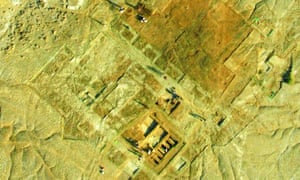

The Kings of the Sealand sound like they come straight out of a fantasy novel but it’s the name given to a royal dynasty who ruled a swathe of Bronze Age Iraq for almost three centuries (ca. 1730-1460 BCE). Archaeologists know almost nothing about the Sealand Kings or their kingdom; all we have to go on are a tiny number of ancient texts, mostly written about them by other rulers. We know they controlled the swampy land around the head of the Persian Gulf, including several of the great ancient cities of southern Babylonia, and we know that they thoroughly annoyed the Kings of Babylon from whom they’d wrestled their kingdom.
In some ways, the Sealand kingdom is a distant ancestor to the many independently minded communities to have thrived in the Iraqi marshes which, like the English Fens, have always resisted external control and provided a refuge for rebels.
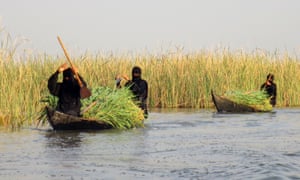
Life in the Iraqi marshes today. Photograph: Mary Shepperson
On the ground, Sealand period remains had never been firmly identified at any archaeological site, but new excavations by a British-Iraqi team have finally found a settlement of the elusive Sealand state. The Ur Region Archaeology Project, in partnership with the University of Manchester and Iraq’s State Board for Antiquities and Heritage, completed excavation at the site of Tell Khaiber this spring. The project was one of the very first international missions to return to southern Iraq in the post-Saddam era, helping to pave the way for other archaeology teams.
Tell Khaiber lies close to the modern city of Nasiriyah and the ancient city of Ur. There’s not much to see on the surface; just an almost imperceptible bulge in the flat, brown mud where centuries of settlement debris have left a lump. It took aerial images to truly reveal Tell Khaiber and the extraordinary building at its centre.
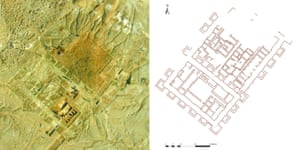
Drone photo of the Tell Khaiber building under excavation in February 2016 (left) with the partially completed ground plan for comparison (right). The building is made up of two parts; the larger north eastern wing is an expansion of the original building. Photograph: Courtesy of the Ur Region Archaeology Project
We only finished tracing the building’s plan in March 2017 but the unusual nature of the ground plan was obvious from the start. The building is huge, covering over 4400 m2, dominating the small settlement. It’s surrounded by a massive mudbrick wall around 3.5m thick, it has just one entrance and its exterior façade is ringed with close-set towers. The building is highly unusual for Bronze Age Mesopotamian architecture and the arrangement of perimeter towers has no known parallel in the region.
So what was this building for and why did it need to be so heavily fortified? We only have partial answers at this stage, but a lot of them come from an archive of inscribed clay tablets found scattered through the rooms of the building’s southern corner. It’s also these documents which place the building squarely in the Sealand kingdom; the few which are dated come from the reign of the eighth Sealand king, the excellently named Ayadaragalama (‘Skilful son of the stag’) who ruled the Sealand around 1500BCE.
Digging up clay tablets is not that fun. In this case they were made of unfired clay; dark brown and slightly soft, like a bar of chocolate. If you touch a tablet with a tool it leaves a mark to go with the hundreds of little surface marks which make up the ancient text. If you scrape a trowel across the surface of a tablet you’ll scrape off the text and the words someone wrote there three and a half thousand years ago are gone forever, and the conservator shakes her head sadly and the epigrapher stops talking to you. It didn’t help that the tablets were broken and mixed up with crushed mudbrick rubble which is remarkably similar in texture and colour, and that if you take too long getting them out of the ground they’ll be split apart by monstrous, fast-growing salt crystals.

A freshly-dug tablet before conservation. Photograph: Mary Shepperson
Anyway, hard work has its rewards (arthritis in my elbow) and at Tell Khaiber we had the first assemblage of Sealand tablets excavated from a secure archaeological context. The tablets are being analysed by Professor Eleanor Robson of University College London and have begun to open a window on the day to day life of the Tell Khaiber building and the Sealand State.
More than 150 tablets and tablet fragments were recovered. They’re written in Akkadian and range from tiny memos inscribed on tablets the size of a USB stick up to account ledgers the size of an ipad. The vast majority of them deal with admin, mostly of an agricultural nature; grain collection, flour storage and goods transfers, the latter often to “the palace”. The palace in question was most likely in the great city of Ur nineteen kilometres to the southeast.
The texts allow us to put some names to Sealand period Tell Khaiber. They include details of hundreds of individuals, sometimes listing their job. Among the farmers and labourers we find many other occupations such as a musician, a cook, a bird-catcher and four “palace ladies” along with their tailor. One tablet lists three “workers who have behaved dishonestly”, presumably noted down for future punishment.
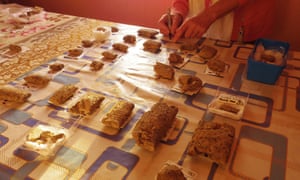
Laying out the tablets on the dining room table at Ur. Photograph: Mary Shepperson
Several of the tablets are school texts, produced by trainee scribes. They’re written in Sumerian, an old language more or less out of use by this time, and they consist mostly of standardised lists of obscure words for metals or stones or animals. These exercises were pretty useless in practical terms, rather like schoolchildren copying out ancient Greek verse. One tablet was simply rows of the same big wedge shape practiced over and over again. It’s highly significant that scribal training was going on in the public building, because school texts have only ever been found in domestic houses. Tell Khaiber is the only known Mesopotamian public building where they kept their training in-house.
In fact, an awful lot seems to have been going on inside the Tell Khaiber building. We found reception rooms, accommodation blocks, cooking areas, an administrative wing and storage rooms all inside the formidable fortifications. It doesn’t fit the usual models of temple, palace or barracks. This unusual multi-functionality may in fact be the key to understanding Tell Khaiber.
An area of mudbrick paving (left) with archaeologists trying to define the walls of the room next door. Photograph: Courtesy of the Ur Region Archaeology Project
All the important functions of the settlement were inside the main building’s walls and towers. In short, the Tell Khaiber building seems to have been set up to withstand attack, the likelihood of which must have been high to warrant the construction of such a heavily fortified complex. The relatively small population which seems to have lived outside the walls could have easily fit inside the building for short periods, and with such big walls and just a single entrance the building could have been defended with just a small body of soldiers. The tablets list two groups of ten “royal auxiliary troops” drawing rations.
Tell Khaiber seems to have acted almost like a medieval castle. In the good times the land was farmed and revenues sent to the King. When enemies arrived everything and everyone could retreat inside the ‘keep’, safe behind its walls and towers. This is not the way Bronze Age Mesopotamian settlements usually worked. The Sealand state was a kingdom which clearly had to protect itself to survive, and in response, it built a castle.
Work at Tell Khaiber was made possible through the generous funding of Baron Lorne Thyssen-Bornemisza at the Augustus Foundation. The project has also been supported by Kirintec, SKA International Group, the British Institute for the Study of Iraq, the FCO and many others. Many thanks go to our colleagues at the SBAH and the Iraq Museum.
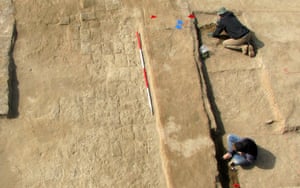
No comments:
Post a Comment